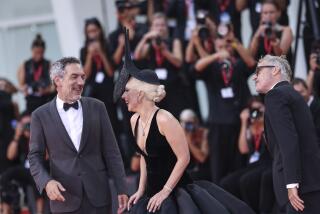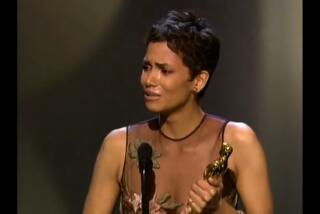CURTAIN TIME FOR APPLAUSE : Guidelines on When a Big Hand for a Star Is Not Too Bright
- Share via
As Sam Shepard’s “Buried Child” begins, an old man is silently crumpled up on a couch, wrapped in a blanket. Off in the corner, a TV set is turned on, but not tuned in; a white fuzz fills the screen. Gradually, as the lights rise, we become more aware of the old man’s features. And then . . .
Someone in the audience starts clapping. At least this was what happened when I saw “Buried Child” at South Coast Repertory. Immediately, a whispered “shhhhh” arose from the rows around him, and the clapping stopped. But the unsolicited applause--and the subsequent “shhhhhs”--had already broken the spell of that first scene.
Why would anyone applaud at such an inappropriate moment? I didn’t interrogate this particular offender, but I’ll bet the demonstration had something to do with the fact that the grizzled old man up there was . . . Pa Walton.
Ralph Waite, known to America as John-Boy’s dad on “The Waltons,” was playing Dodge, the “Buried Child” codger. The applauder couldn’t have been honoring Waite’s performance as Dodge--it had just begun. Instead, the clapping was for Waite/Walton, despite the fact that “Buried Child” is virtually a parody of “The Waltons.”
As I drove home, I found myself wishing there were rules that would establish when it’s permissible to applaud a famous actor’s first entrance. Rules like these:
Never clap the first clap. First-scene applause is a disruption unless the whole audience (minus a few churlish critics) joins in. Don’t stick your neck out as the leader of the pack; the pack may be smaller than you imagined. This is especially important if you’re in the balcony or the back of a big house, where it’s hard to make out the actors’ faces; you may find yourself mistaking an extra for your favorite matinee idol.
Don’t even think about applauding your first glimpse of a star unless the play is a musical or a light comedy. While a burst of premature clapping might be tolerable at Stephen Sondheim’s “Company,” anyone who does it at Samuel Beckett’s “Company” should be sentenced to remedial-audience classes.
Don’t indulge in this habit at a nonprofit theater. Theaters that apply for grants don’t want to be known as star showcases. If they relied on stars to attract crowds and donors, why would they need grants? They’re there to serve the play and the playwright, or so they want you to believe, and it’s bad form to disregard this.
Don’t applaud an actor’s arrival on an Equity Waiver stage, especially if it’s in the Hollywood-Beverly Hills Waiver belt. The person next to you is likely to be an agent or a producer--or someone who aspires to such titles. He or she looks at the actors as job applicants; early applause is a presumptuous interruption of the job interview. You aren’t doing your chosen actor any favors, either; it looks as if the actor has packed the house with a claque.
Don’t do it in any theater with fewer than 500 seats. The smaller the crowd, the more embarrassing it is to be one of the few who’s applauding--everyone can see who you are.
Never applaud the entrances of more than two actors in one show. The Ahmanson’s “Picnic” included four stars of popular TV series, plus a couple of other semi-famous names. Some people apparently saw it as an opportunity to exercise their hands. By the entrance of the fourth or fifth star, even the applause zealots may have had enough, but they didn’t want to snub anyone. The obvious solution--no applause until the final curtain calls.
With all these pesky regulations, you may wonder when you can ever applaud the sight of a star. Here are a few clues:
An exclamation point in the play title is often an applause license. For example, it’s OK at “Legends!” or “Hello, Dolly!” or anything else with Carol Channing.
If the TV ads for the production focus on the stars arriving at the theater instead of the play itself, feel free. This was the case with Elizabeth Taylor and Richard Burton in “Private Lives.”
If the actors wink and nod at you upon entering the stage, as they do in the Los Angeles Theatre Center’s “Tartuffe,” chances are you’re supposed to applaud. This is the exception to the nonprofit rule (see above).
The entrance of an octogenarian who looks 30 years younger is an event made for applause--in the right kind of play, of course, such as “Aren’t We All?” with Claudette Colbert.
But when in doubt--don’t.
More to Read
The biggest entertainment stories
Get our big stories about Hollywood, film, television, music, arts, culture and more right in your inbox as soon as they publish.
You may occasionally receive promotional content from the Los Angeles Times.










